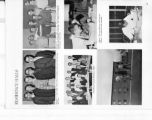| Title |
1960 Utonian |
| Note |
The University of Utah has made former and current yearbooks from various campus entities available in print and via its digital library archive. These documents contain facts and milestones about the history of the University of Utah. In some cases, these publications contain insensitive and offensive language and imagery that does not represent the views or values of the University of Utah. Insensitive and offensive portrayals of race and gender were wrong at the time these publications were originally printed, and they are wrong today. The yearbooks are presented as they were originally created and have not been edited or censored-to do otherwise would be the same as claiming these prejudices and biases never existed. - July 2019 |
| Subject |
College yearbooks; University of Utah--Periodicals |
| Publisher |
University of Utah |
| Contributors |
Holt, Gary |
| Date |
1960 |
| Type |
Text |
| Format |
application/pdf |
| Digitization Specifications |
Originals scanned at 400ppi on an Epson Expression 1640XL flatbed scanner. Display images generated in CONTENTdm as JP2000s, 800 pixels in width, 15 to 1 compression rate. |
| Resource Identifier |
Utonian_1960 |
| Source |
LD5538 .U8 1959-1960 |
| Source Physical Dimensions |
32 x 24 cm |
| Language |
eng |
| Relation |
J. Willard Marriott Library, University of Utah, Salt Lake City, Utah, United States |
| Coverage |
1959-1960 |
| Contributing Institution |
J. Willard Marriott Library, Special Collections |
| ARK |
ark:/87278/s64j0fxr |
| Setname |
uum_utonian |
| ID |
743864 |
| Reference URL |
https://collections.lib.utah.edu/ark:/87278/s64j0fxr |




















































































































































































































































































































































































































